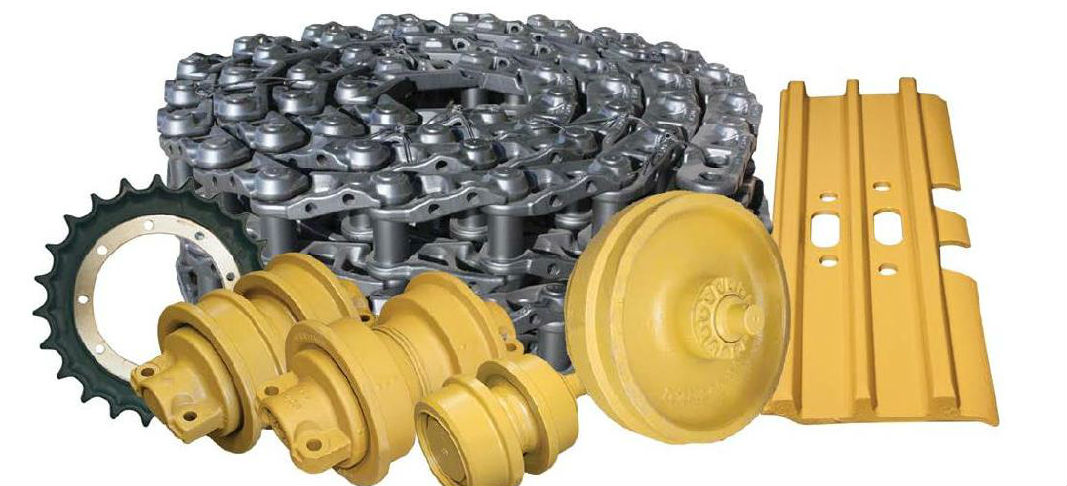Boost Efficiency: How Updating Undercarriage Parts Can Boost Effectiveness
Wiki Article
Crucial Overview to Undercarriage Components for Heavy Equipment
When it comes to hefty equipment, the undercarriage plays an important role in ensuring effective and smooth procedures. From track chains to idlers and rollers, each component contributes to the overall performance of the devices.Relevance of Undercarriage Components
Comprehending the crucial function that undercarriage components play in the efficiency and durability of hefty devices is vital for effective upkeep and operation - undercarriage parts. The undercarriage elements form the structure on which the whole equipment operates, supporting the weight of the devices, giving stability, and soaking up shock lots during operation. A properly maintained undercarriage not just guarantees smooth operation but also contributes dramatically to lowering downtime and repair costs
The undercarriage consists of various crucial components such as track chains, track shoes, gears, idlers, rollers, and track frames. The track chains and track footwear help in supplying traction and support, while the idlers and sprockets assist in driving the tracks smoothly.
Kinds Of Track Chains
Track chains are important parts of hefty equipment undercarriages, supplying the essential traction and assistance for reliable procedure. There are mainly 2 sorts of track chains utilized in hefty tools: sealed and oiled track chains (SALT) and completely dry track chains. Sealed and oiled track chains are generally located in contemporary heavy equipment. These chains are pre-lubricated and sealed to stop dust, debris, and dampness from going into the chain joints, making certain smooth operation and prolonging the chain's life-span. On the other hand, dry track chains need normal hand-operated lubrication to preserve optimal performance and stop premature wear.
Duty of Rollers and Idlers
Rollers and idlers play an important function in sustaining and guiding the track chains of heavy devices undercarriages, contributing to the overall security and efficiency of the equipment. Idlers, on the other hand, guide the track chain and help keep correct stress throughout the undercarriage system.With each other, idlers and rollers function in consistency to guarantee that the track chain remains in area, even on rough surface, boosting the devices's performance and long life. Appropriate maintenance her comment is here and normal inspection of idlers and rollers are important to stop early wear and potential failures, eventually maximizing the effectiveness and lifespan of hefty tools undercarriages.
Recognizing Gears

One essential aspect of gears is making certain correct alignment and stress to avoid early wear and damages. Misaligned sprockets can trigger unequal endure the track chain, resulting in decreased efficiency and possible safety and security hazards. Normal upkeep and evaluation of sprockets are necessary to identify any kind of signs of wear or misalignment quickly.
Additionally, sprockets can be found in numerous sizes and tooth configurations, depending on click for more the particular heavy equipment and its intended usage. Proper option of sprockets based upon the devices's specs is vital to ensure ideal efficiency and durability of the undercarriage system. Understanding the function of sprockets and their maintenance demands is critical for making best use of the efficiency and life-span of heavy devices undercarriages.
Upkeep Tips for Durability
To ensure the extended durability and optimum performance of heavy tools undercarriages, thorough maintenance techniques are essential. Routinely examining undercarriage components such as track footwear, rollers, idlers, and gears for wear and tear is crucial. Correct track stress modification is likewise vital for lowering early wear on undercarriage components.Verdict
To conclude, undercarriage parts pop over to these guys are necessary parts for hefty equipment, playing critical roles in preserving security and capability. Recognizing the various kinds of track chains, sprockets, idlers, and rollers is necessary for proper maintenance and longevity of the equipment. By adhering to maintenance ideas and frequently examining and changing worn components, operators can make sure the optimal performance and effectiveness of their heavy machinery. Appropriate care and focus to undercarriage components are vital to taking full advantage of tools life expectancy and efficiency.The undercarriage is composed of various necessary parts such as track chains, track shoes, sprockets, idlers, rollers, and track structures. The track chains and track shoes assist in offering traction and assistance, while the sprockets and idlers assist in driving the tracks efficiently (undercarriage parts). There are primarily 2 kinds of track chains utilized in heavy tools: secured and lubricated track chains (SALT) and completely dry track chains. Proper option and upkeep of track chains are crucial to make sure the general performance and durability of hefty equipment undercarriages
Gears are essential parts of heavy tools undercarriages, accountable for transferring power from the machinery to the track chain.
Report this wiki page